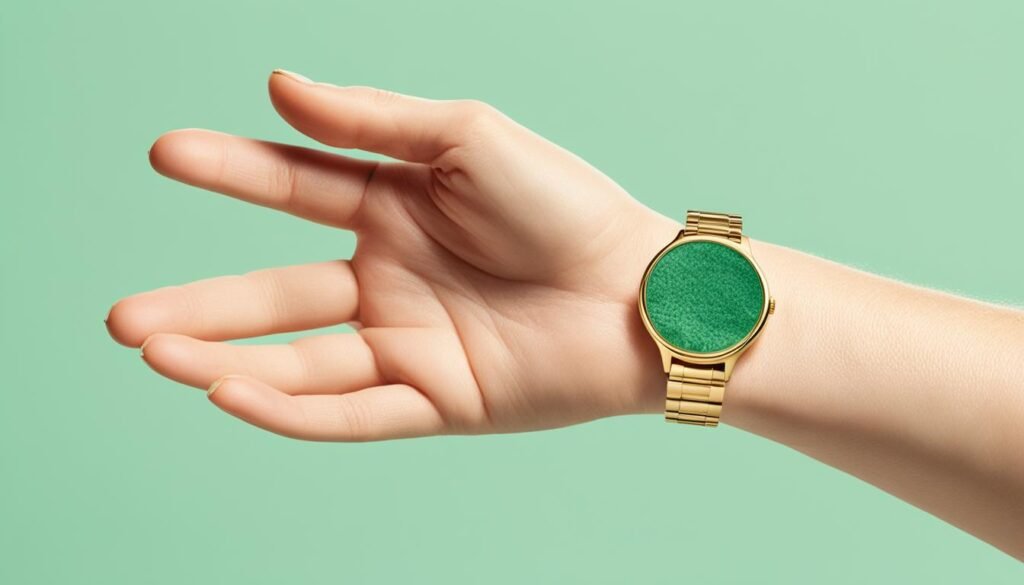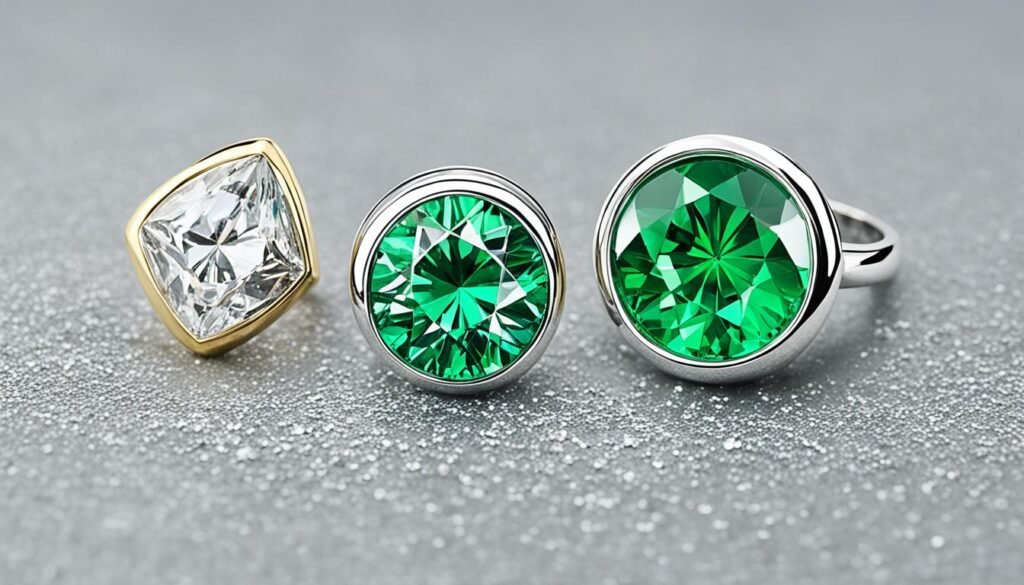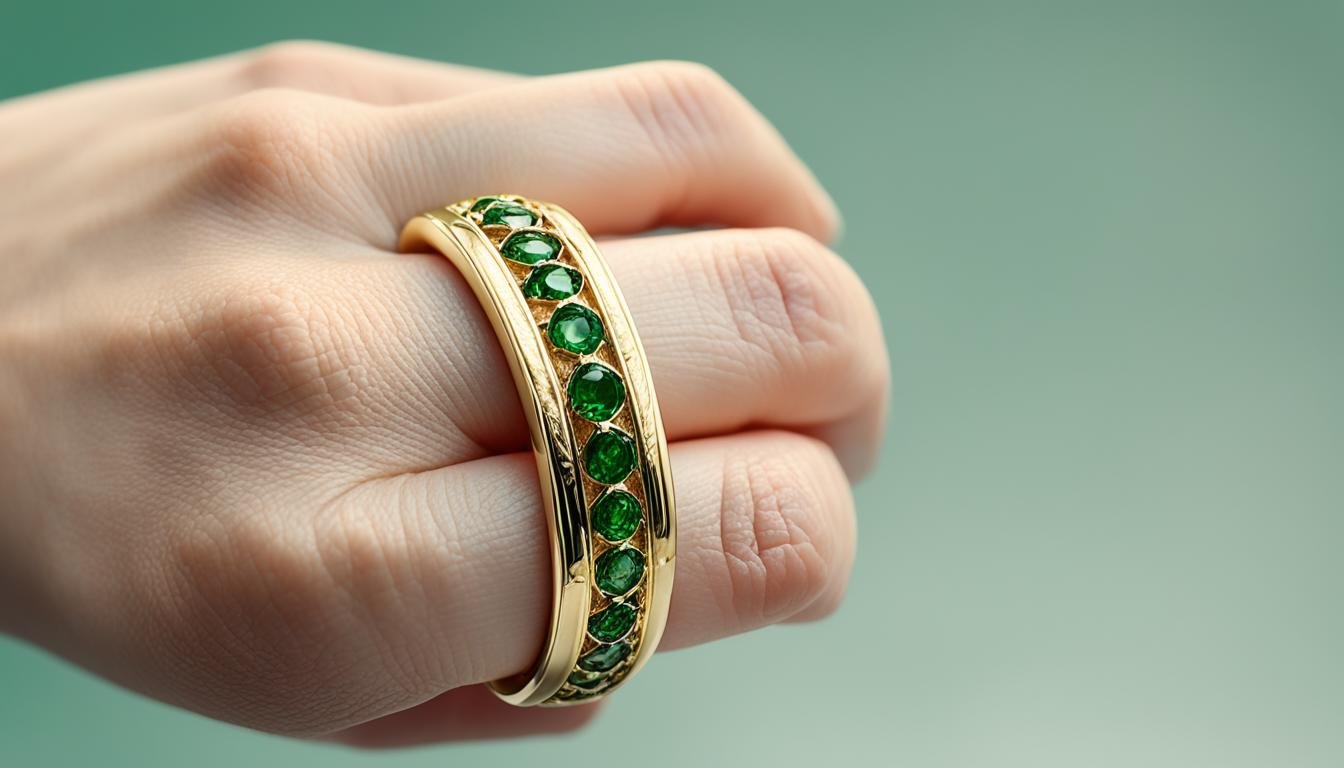Ever wondered why a beloved gold ring can leave a green mark on your finger?
This oddity affects not just low-cost jewelry but also top-quality pieces. We’ll look into why even gold can create a green tinge on your skin from a ring.
Exploring the scientific explanation behind jewelry skin discoloration is key to understanding and preventing this. Yes, even fine gold jewelry may be the source of this annoyance.
Key Takeaways about Why Does Gold Make Your Skin Green
- Gold jewelry can cause skin discoloration due to a chemical reaction with metals like copper and nickel.
- This green tint is a benign reaction, not an allergic response.
- Skin oils, lotions, and perspiration play a significant role in causing the green discoloration.
- Pure gold is usually alloyed with other metals for durability, which can lead to tarnishing.
- There are preventive measures like hypoallergenic jewelry alternatives to avoid this occurrence.
Understanding the Chemical Reaction Behind Skin Discoloration
Skin discoloration from jewelry is an interesting topic. It often happens because of complex chemical reactions. The usual green color comes from the metal in the jewelry. It reacts with things like air, water, and sweat.
Oxidation
The oxidation process is a key reason for skin turning green. When metals like copper mix with gold, they can rust. This rust, called copper oxide, can color the skin green.
Solubility
There’s also a soluble chemical reaction that matters. Sweat with salt and lactic acid can make metals dissolve. This can turn the skin blue or green by staining it.
Corrosion
Chlorine from pools or cleaning products can cause corrosion. It makes skin go green. But, it can also harm the jewelry.
Sulfur and Amino Acid Reaction
Some medicines can make your sweat have more sulfur. This sulfur, and the amino acids in sweat, can make jewelry dark. They also add to the green marks on the skin.
Common Metals in Gold Jewelry That Cause Discoloration

Gold jewelry is loved by many, but it can discolor the skin because of added metals. Two common metals, copper and nickel, often make the skin look green. They are used to make gold jewelry tougher but can make your skin change color.
Role of Copper and Nickel
Copper in gold jewelry can turn the skin green. When copper in the jewelry meets sweat or water on the skin, it turns into copper chloride. This is what makes the skin have green marks. Nickel works in a similar way, causing the skin to change color as well.
Importance of Alloy Composition
The metals mixed with gold affect how likely it is to change the skin’s color. Jewelry with more pure gold and less copper and nickel might not make your skin green. But, pieces with more of these metals are more likely to cause this effect. Knowing what your jewelry is made of can help prevent skin discoloration.
| Type of Gold | Pure Gold Percentage | Alloy Metal Percentage | Likelihood of Discoloration |
|---|---|---|---|
| 24K (Pure Gold) | 99.9% | 0.1% | Low |
| 18K Gold | 75% | 25% | Medium |
| 14K Gold | 58.3% | 41.7% | High |
| 10K Gold | 41.7% | 58.3% | Very High |
Why Discoloration Doesn’t Equate to Health Risks

Seeing a greenish hue on your skin from some jewelry can be strange. But it’s key to know it’s harmless. This change in color reveals a safe chemical reaction, not a health scare. It often happens with jewelry made from metals like copper and nickel. Even if these metals stain your skin, they aren’t dangerous when they touch it.
Buy Gold Online: The Smart and Secure Way
Discover the safest and most reliable strategies to buy gold online. Make informed investment decisions and secure your financial future today!
Learn MoreDon’t confuse this with allergic reactions like itching or redness. When you have an allergy, you might need to avoid certain metals. But, the green tint on your skin shows there’s no allergy. It’s just your skin reacting in a way that seems greenish because of the metal and your sweat and natural oils.
Choosing jewelry that uses hypoallergenic metals helps those who react badly to regular jewelry. For most people, knowing this green tint is not harmful makes it easier to enjoy their jewelry. With some smart choices, you can keep wearing your favorite pieces without worrying about your health.
Here’s a look at different metals used in jewelry and how they affect the skin:
| Metal | Potential Skin Reaction | Health Risks |
|---|---|---|
| Copper | Green Discoloration | None (Safe Skin Discoloration) |
| Nickel | Possible Allergic Reaction | Minor Allergy in Sensitive Individuals |
| Gold (Pure) | None | None |
| Platinum | None | None (Hypoallergenic) |
Does Gold Make Your Skin Green? Examining the Facts

Many people are surprised when their golden jewelry turns their skin green. Pure gold jewelry does not usually react like this. We’ll look at why this happens. This includes the difference between pure gold and mixtures, how our skin’s pH matters, and what beauty products do to our jewelry.
Differences Between Pure Gold and Alloyed Gold
Most gold jewelry you see is not pure gold. They mix it with other metals for strength. Pure gold doesn’t change color. But mixed gold can react with the air and your skin. This makes it look green on some people.
Impact of Skin pH and Body Oils
Our skin’s pH and the oils we naturally produce are key. If your skin is more acidic, you might see your jewelry change color more. Body oils mix with the metal in the jewelry. This makes it more likely to leave a green mark.
Effect of Beauty Products and Chemical Exposure
Cosmetics and beauty products can speed up the color change. These include lotions, perfumes, and sprays. They have chemicals that react with the metal. Even cleaning products can make your jewelry turn your skin green. It’s important to know how these substances can affect your jewelry to prevent it.
Tips to Prevent Your Jewelry from Turning Your Skin Green

Seeing your jewelry turn your skin green can be a letdown. But, there are things you can do to avoid this. Follow these helpful tips to enjoy your jewelry without worries about your skin.
Applying Protective Coatings
Adding a protective layer on your jewelry is very effective. You can use clear nail polish on the metal parts that touch your skin. This barrier lessens the chance of your skin turning green. Remember, you might need to reapply the nail polish now and then.
Avoiding Jewelry During Certain Activities
Don’t forget to take off your jewelry before you do certain things. Activities like swimming, bathing, or even working out can make your skin reactions worse. Removing the jewelry before you do these activities can help you avoid the issue completely.
Choosing Alternative Metals
If you often get skin reactions, choose hypoallergenic jewelry. Metals that are good for sensitive skin include platinum, rhodium, and stainless steel. Also, wearing jewelry with rhodium plating can prevent green skin, which is great for those with sensitive skin.
Here’s how various metals compare in terms of their effect on skin:
| Metal | Tendency to Cause Discoloration | Recommended for Sensitive Skin |
|---|---|---|
| Copper | High | No |
| Nickel | High | No |
| Platinum | Low | Yes |
| Rhodium | Low | Yes |
| Stainless Steel | Low | Yes |
Conclusion
It’s important to know about jewelry metals to understand green skin. When you wear gold, your skin might turn green. This happens when your skin’s oils mix with metals like copper and nickel in gold jewelry. Yet, it doesn’t mean the jewelry is bad.
Each person’s skin reacts differently with jewelry. Knowing what metals are in your jewelry can help avoid skin issues. You might choose metals like platinum or stainless steel. These are less likely to turn your skin green.
There are ways to enjoy your jewelry without the fear of green skin. You can coat the jewelry, keep it dry, and choose less reactive metals. By doing this, your favorite pieces can stay beautiful and safe to wear.
FAQ about Why Does Gold Make Your Skin Green
Why does gold make your skin green? Facts revealed.
The green tint from gold jewelry is because of a reaction with skin oils, lotions, and sweat. It’s not an allergy. Copper and nickel, in gold alloys, cause this interaction. They make the gold stronger.
What is the chemical reaction behind skin discoloration?
Copper in the jewelry mixes with oxygen. This creates copper salts, leaving a greenish color. Sweat compounds and air quality impact the reaction too.
How does oxidation cause skin discoloration?
Copper in jewelry reacts with air and water. This forms copper oxide or copper carbonate, leading to the green color on skin.
How does solubility affect metal reactions with skin?
Sweat compounds like sodium chloride dissolve the metal. This makes a greenish stain on your skin.
How does corrosion contribute to green discoloration?
Chlorine in pools or cleaning products reacts with the jewelry. This can turn your skin green and harm the jewelry.
What is the sulfur and amino acid reaction?
Medications can raise sulfur and amino acids in sweat. This makes copper in the jewelry react, causing dark spots on the jewelry.
What metals in gold jewelry cause discoloration?
Gold jewelry may have copper or nickel. They’re added to make the gold hard. But they might turn the skin green.
How important is alloy composition in jewelry?
The mix of metals in jewelry is key. More gold and less of other metals reduce skin reactions. But more copper or nickel could turn the skin green.
Can skin discoloration from jewelry pose health risks?
No, the green tint is not harmful. It’s not an allergy. This issue can be avoided with care and awareness.
Does pure gold make your skin green?
Pure gold doesn’t discolor skin. But mixed with copper, it might. Skin and the environment also affect this.
How do skin pH and body oils affect jewelry?
Skin acidity and oils can affect jewelry. This interaction, made worse by lotions and perfumes, can stain the skin.
How do beauty products and chemical exposure contribute to discoloration?
Beauty products and chemicals can react with the metal. This might make your skin green. Be cautious of this effect.
What are some tips to prevent jewelry from turning your skin green?
Use clear nail polish to create a barrier. Avoid wearing jewelry when you’ll sweat or be near water. Choose metals like platinum or stainless steel instead.
How can protective coatings help with skin discoloration?
A protective coating stops the skin from directly touching the metal. This can lower the chance of your skin turning green.
Should I avoid wearing jewelry during certain activities?
It’s smart to take off jewelry before swimming or bathing. Moisture can make your skin turn green more quickly through oxidation.
What are the best alternative metals to prevent skin discoloration?
Metals including platinum, rhodium, and stainless steel are good choices. Rhodium-plated jewelry is also effective in preventing skin discoloration.

